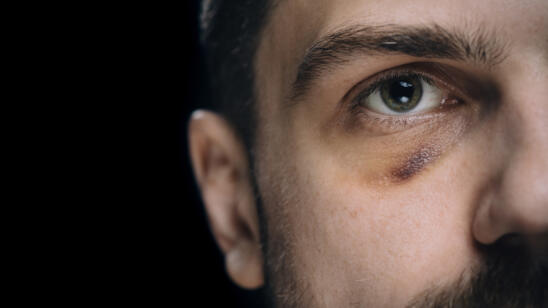On Valentine’s Day, 1995, eight years into a toxic marriage, bodybuilding spouses and former Marines Sally and Ray McNeil had their final argument.
With a 12-gauge shotgun she grabbed from a closet, Sally blasted one round into Ray’s abdomen. After her husband dropped to his knees, she reloaded and fired again at his face. The couple’s two young children, 11-year-old Shantina and 9-year-old John, were in the house during the shooting.
At the time, the McNeils were professional bodybuilding’s most famous couple, with Ray reaching the pinnacle of his career when he was crowned Mr. California in 1991. Sally was also a formidable competitor, twice winning the U.S. Armed Services Physique Championship in the late 1980s. But the couple’s volatile relationship was consumed by jealousy, infidelity, physical abuse and ‘roid rage, according to press reports.
[Stream episodes of American Justice in the A&E App.]
“My life with Ray was very turbulent,” Sally recalled in an interview with RxMuscle.com years later. “I left him about three times, and he followed me to my new address… Looking back, I should have left him after the third day of our marriage.”
Sally McNeil’s Battered Wife Defense
Sally made a living as a female submission wrestler (submission wrestling is a form of wrestling that is typically done on the ground that uses holding moves with the aim to get an opponent to tap out). On the day of the murder, Sally, who was known as “Killer Sally” and “Killer McNeil,” called 911 and told police Ray choked her, prompting her to arm herself and shoot him because she feared for her life. As he lay bleeding, Ray shook his head in denial, and gasped out, “No!,” the New York Daily News and other media outlets reported. After being taken to a hospital, Ray succumbed to the gunshot wounds.
Despite her self-defense claims, Sally was charged with first-degree murder. Prosecutor Daniel Goldstein portrayed her as the relationship’s violent aggressor who killed Ray in order to collect on a life insurance policy—and because she was incensed that he was going to leave her, according to a 2015 Muscular Development story.
At the time of her arrest, Sally tested positive for the steroid Deca-Durabolin, and Ray’s autopsy revealed he had five different kinds of steroids in his bloodstream, according to news reports. Prior to killing her husband, Sally had been arrested on various occasions for alleged violent assaults, including beating up a woman at a bodybuilding competition whom she suspected was having an affair with Ray.
At trial, a defense expert testified that Sally had battered woman syndrome, or BWS, after conducting several clinical interviews with her in which she recounted years of mental and physical abuse by her husband. Sally alleged Ray injured her numerous times, including breaking five of her bones at various times during their marriage. The expert told jurors that Sally’s BWS would have caused her to shoot Ray as a result of her genuine perception that she was in imminent danger.
Psychiatric and legal scholars specializing in domestic violence told A&E True Crime that Sally’s case has the hallmarks of BWS, most notably her fear that leaving Ray would have only made the situation worse.
“People don’t understand why someone would stay with a person who treats them so badly,” says domestic violence expert Dr. Don Dutton. “But a victim with battered woman syndrome suffers from low self-esteem, trauma, anxiety and depression. They also form an unnatural attachment to the abuser.”
Dutton, a University of British Columbia professor emeritus of psychology, says proving that BWS is an underlying cause in killing an abusive spouse as an act of self-defense can be complicated.
“A jury has to sort out if it even seems plausible that she was really in fear for her life,” Dutton says. “[Sally’s case] is as close to a classic battered woman syndrome self-defense as you can get.”
Sally McNeil’s Conviction and Appeals
The jury in her 1996 trial didn’t buy Sally’s defense, convicting her of second-degree murder. She is currently serving a life sentence in a California state prison. Sally appealed her conviction on the grounds that the judge wrongfully precluded jurors from considering her expert’s testimony in determining whether she had a reasonable belief to defend herself from deadly harm.
CarolAnn Peterson, a University of Southern California domestic violence lecturer, tells A&E True Crime that juries that are allowed to consider BWS in cases involving spousal homicide are more likely to acquit. When evidence of BWS is excluded, she says, jurors are more apt to convict.
“Judges should allow juries to consider BWS so they can understand the full scope of what happens in an abusive relationship,” Peterson says. “With a jury, it’s very possible you have people who have not been through domestic violence or have a close relative who has. So they may think the victim can simply leave the house. And it is not that easy.”
In 2003, the U.S. Ninth Circuit Court of Appeals sided with Sally and overturned her conviction. The State of California took the fight to the U.S. Supreme Court, which reversed the appeals court ruling. In 2005, the appeals court reinstated Sally’s conviction based on the higher court’s opinion.
Even if the jury was allowed to consider Sally’s BWS, it may have not resulted in a more favorable outcome, Kit Kinports, a Penn State University law professor, tells A&E True Crime.
“It appears there was violence on both ends, which is not uncommon,” Kinports says. “But it doesn’t make you look helpless. Since the jury convicted her of second-degree murder, it seems they didn’t believe she was honestly afraid. Even today, it is hard for women to get acquittals in these types of cases.”
Related Features:
Acting in Self-Defense: What It Means in the Eyes of the Law
How Sherra Wright Orchestrated the Murder of Her Ex-Husband, NBA Star Lorenzen Wright
Stacey Castor and Other Women Who’ve Gone to Great Lengths to Kill Their Husbands
The Murder of Army Sergeant Tyrone Hassel III: A Love Triangle Gone Deadly


